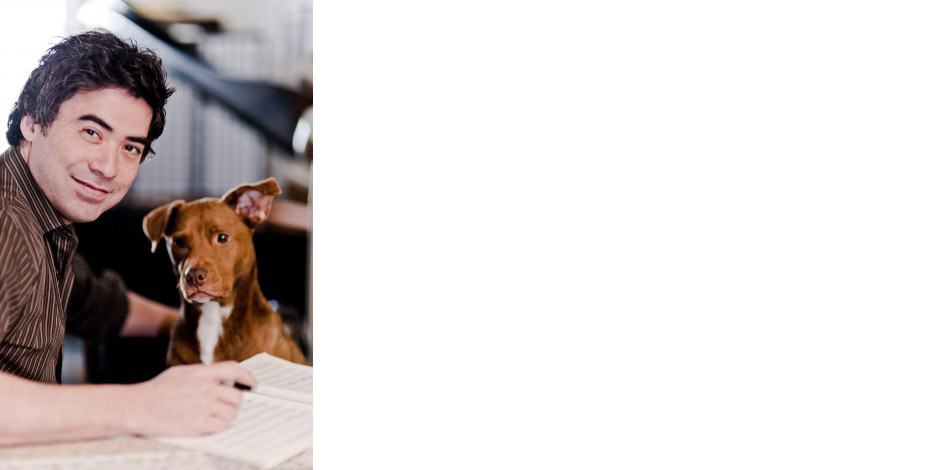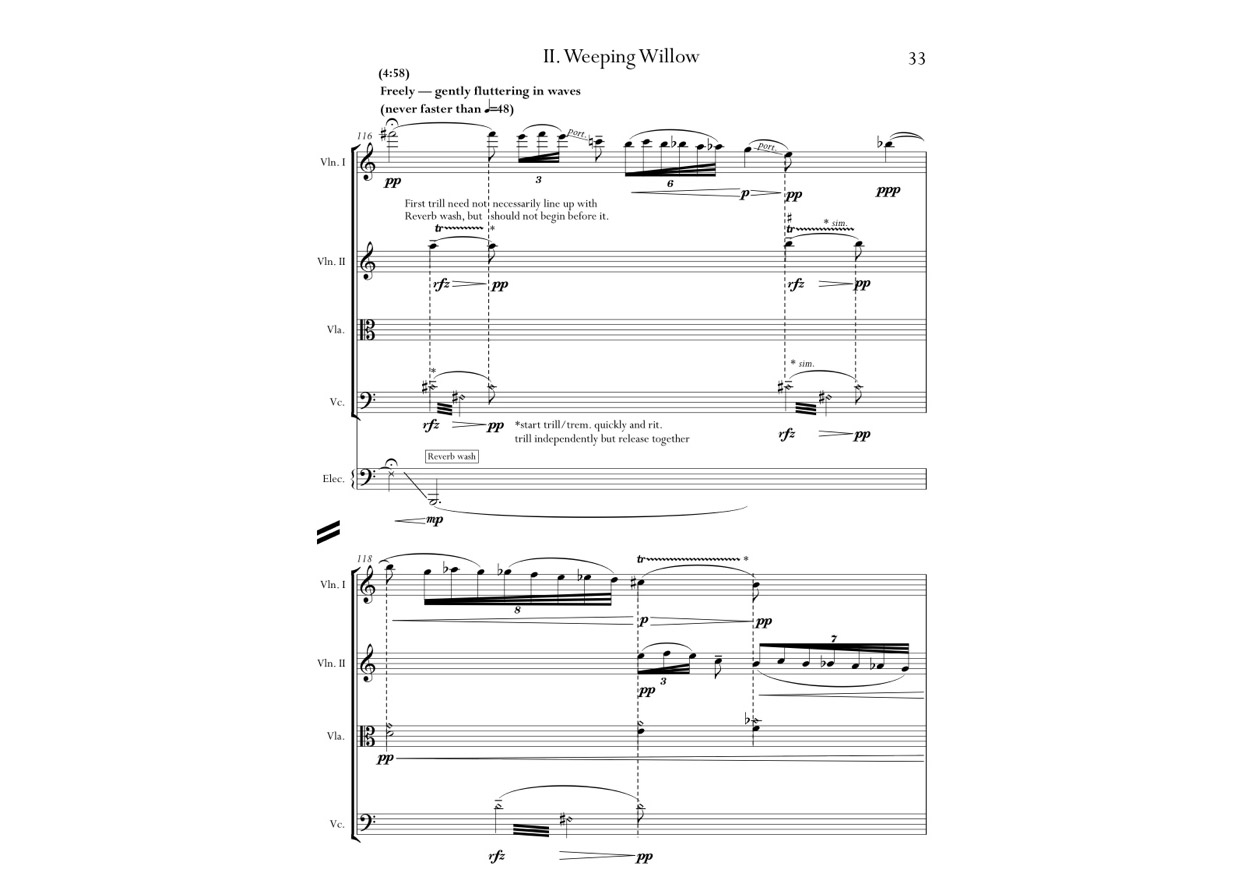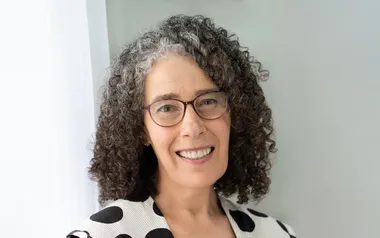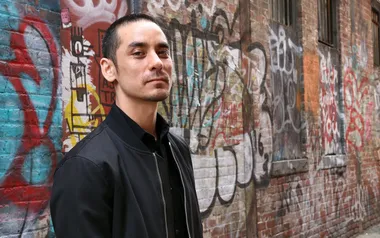Blog
NOVEMBER 21, 2024
The Portland School

What makes a “school” of art?
Typically, it refers to artists who developed a similar style through proximity, sharing a similar development path, which may be the best way to describe what’s happening on our contemporary music scene in Portland over the past few years.
It really is remarkable how the local scene has recently welcomed the arrival of some of the biggest names in the new music world, including several we’re presenting on our December 3rd concert. This has added to an already strong musical scene to present us with an abundance of creative riches, both in terms of the composers we’re so lucky to have here, but also in the number of performing ensembles who are bringing their music to the stage.
I’m VERY excited at what the future holds, particularly with the possibility that Portland composers may begin to find stylistic common ground, born of their proximity and shared love for our fair city and its quirks.
As we continue to emerge from a difficult few years, it’s wonderful to see more and more creative artists viewing Portland as the best place to call home. Once again, creative musical art will show the way forward to a revitalized city. School is in session!
We look forward to performing these works for you by our fellow Portlanders!
Ron Blessinger
Violinist, Oregon Symphony & 45th Parallel Universe Development & Production Coordinator, Curator of Special Projects, 45th Parallel Universe
The Portland School
Performed by Pyxis Quartet
With special guests Darrell Grant, Kirsten Volness, Zach Galatis, and Maria Garcia
December 3rd, 2024
7:00pm @ The Old Madeleine Church
Click here for tickets

Kenji Bunch
Over the past thirty years, Kenji Bunch has established himself as one of America’s most engaging, influential, and prolific composers, with genre-defying music that has been performed on six continents and by over seventy American orchestras. Cited by Alex Ross in his seminal book The Rest Is Noise and dubbed “One of the new faces of new music” by the NY Times (A. Tommasini), Bunch’s unique compositional voice has earned acclaim from audiences, performers, and critics alike.
Influenced by his mother’s experience as a Japanese immigrant, his father’s as a political/social activist, and his childhood spent in the meditative natural beauty of the Pacific Northwest, Bunch combines his interests in history, philosophy, nature, and intergenerational and cross-cultural dialogue with the intention to entertain, inspire, and facilitate healing with his music – at times with vulnerable sincerity, irreverent humor, dazzling virtuosity, or by confronting difficult issues of trauma from our shared histories.
The 3Gs
This piece is a rare virtuoso display piece for the viola, written in a musical space somewhere between funk and fiddle. Its title has several meanings, according to the composer. First of all, the viola is tuned in scordatura, which means that the strings are not tuned to their customary pitches. On the viola, from bottom to top, they are normally C-G-D-A. For this piece the strings are tuned G-G-D-G - which is known in fiddle music as the “Napoleonic” or “Dead Man’s” tuning. It has three G’s, hence the first meaning. The second, when he was writing this piece back in 2005, was a result of a very bad sinus infection Kenji suffered, which made his face feel as though it were under 3 G’s of gravitational force. The third G? At the time he owed his landlady $3000. It’s a joy to play, and thankfully I don’t suffer from the last two G’s!

Gabriel Kahane
Hailed as “one of the finest songwriters of the day” by The New Yorker, Gabriel Kahane is a musician and storyteller whose work spans the theater, club, and concert hall.
Highlights of his 2024-25 season include a return to the New York stage in a production at Playwrights Horizons of two solo works, Magnificent Bird and Book of Travelers, which Gabriel performs in repertory. In addition, he tours as a duo with fellow composer/performer Caroline Shaw in the United States and Europe, including performances at the Philharmonie de Paris, Wigmore Hall, and the Concertgebouw. This season also witnesses the premiere of a clarinet concerto for Anthony McGill, a solo debut with the Orchestre National de Lyon, as well as Kahane’s San Francisco conducting debut in Carla Kihlstedt’s Twenty-six Little Deaths.
Little Love
In his New Yorker essay, Alex Ross describes Kahane’s Little Love (from Book of Travelers) as two people describing a favorite seaside spot and singing, “I hope we die here when we’re old:”
And when we’re frail in our lawn chairs by the sea,
All twisted hands, shrunken spines, and halting speech,
We’ll listen for the long gray silence to gather and increase,
And when it does we’ll close our eyes and rest in narrow peace.
This assumes, of course, that the couple will stay together, that they will grow old together, and that their cherished beach will still exist. The song ends in mid-air, with an unresolved cadence, suggesting that they know no better than the rest of us how all of this will end.

Kirsten Volness
Internationally recognized composer Kirsten Volness creates sublimely intimate and emotive soundscapes that inspire immersive listening. Through the refined use of electronics and modern composition techniques overlaid with jazz and pop influences, Volness’s music is both groovy and graceful, “irresistible” (San Francisco Chronicle) and “nothing short of gorgeous” (New York Arts). Each of her compositions reveals “an exquisite sound world” (New Classic LA) with disparate, suggestive musical elements and idioms woven together to create sonic atmospheres that hold listeners in beauty and fascination. Inspired by nature, myth, spirituality, and environmental and sociopolitical issues, Volness’s music is smart, relevant, timeless, and transcendent.
The Tree of Life
“The Tree of Life appears in numerous cultures throughout history and it represents the interconnectedness of everything on Earth and in the spirit world, above and below. In the Japanese Shinto tradition, natural features such as waterfalls, mountains, and so on, are believed to house kami, or spirits, who bring blessings or mischief to the human realm. I chose to integrate these ideas by exploring, as I imagine them, the spirit presences of my favorite types of trees and to consider what they might bring to share in the larger fabric of life, death, the world we can see, and the worlds we may not yet have experienced.”
— Kirsten Volness
In Kirsten’s beautiful composition, recorded wind chimes, whistles, flowing water, and other earthly sounds integrate with our string quartet to paint three different scenes inspired by trees:
White Birch: The quiet and ethereal music at the beginning gives way to a dance of triplets, described by Kirsten as “Always propelling forward.”
Interlude I: A gorgeous melody played by the viola takes the music from the dance of the previous movement to a contemplative place, setting us up beautifully for the next movement.
Weeping Willow: Notes fall like willow branches, represented in the score with notation that actually looks willow-like. The movement builds to an amazing peak, as though we’ve managed to climb the enormous willow to see the sunrise.

Electronic Interlude: The sounds of nature have transformed into fully electronic sounds, with the two violins engaged in a dance with the sprightly soundtrack.
Coast Redwood: “Snappy and cute, with strong accents.” We begin the movement with pizzicato plucking and another dance texture, now in 4/4 time. The frolic gives way to a contemplative and beautiful conclusion to the piece, in which Kirsten directs us to play “Graciously, with humility.”

Darrell Grant
Through eight albums as a bandleader, numerous recordings as a sideman, a growing body of compositions, and two decades of service as an educator and leader in the arts, Grant’s multi-faceted creative projects and innovative initiatives reflect a belief in the extraordinary power of art to communicate, inspire, provoke, inform, and move others to transform society and themselves.
Crossing the Bridge: Vanport
Check out this video in which Darrell shares his personal journey of learning about the musical history of Portland’s Black community. Once a vibrant mecca, Portland's jazz scene was decimated when the Black community was displaced by freeways and structures. This moving episode concludes with Grant performing his piece Crossing the Bridge: Vanport with musicians of the Oregon Symphony. The song speaks to his belief that “human beings can find ways to communicate across the things that divide us” and is a tribute to those responsible for Portland’s jazz scene in the 1940s.

Caroline Shaw
Portlander Caroline Shaw is a musician who moves among roles, genres, and mediums, trying to imagine a world of sound that has never been heard before but has always existed. She works often in collaboration with others, as producer, composer, violinist, and vocalist. Caroline is the recipient of the Pulitzer Prize in Music, several Grammys, and an honorary doctorate from Yale. Her favorite color is yellow, and her favorite smell is rosemary.
Blueprint
In the 1820s, artists in Japan began to import a particular blue pigment known as “Prussian blue,” which was first synthesized by German paint producers in the early 18th century and later modified by others as an alternative to indigo. The story of aizuri-e is one of innovation, migration, transformation, craft, and beauty. Blueprint, composed for the incredible Aizuri Quartet, takes its title from this beautiful blue woodblock printing tradition as well as from that familiar standard architectural representation of a proposed structure: the blueprint. This piece began its life as a harmonic reduction – a kind of floor plan – of Beethoven’s string quartet Op. 18 No. 6. As a violinist and violist, I have played this piece many times, in performance and in joyous late-night reading sessions with musician friends. (One such memorable session included Aizuri's marvelous cellist, Karen Ouzounian.) Chamber music is ultimately about conversation without words. We talk to each other with our dynamics and articulations, and we try to give voice to the composers whose music has inspired us to gather in the same room and play music. Blueprint is also a conversation – with Beethoven, with Haydn (his teacher and the “father” of the string quartet), and with the joys and malinconia of his Op. 18 No. 6. (program note by Caroline Shaw, March 2016)
Don’t forget to share this post!
YOU MAY ALSO LIKE…

Take Me to the River
On April 30th, 45th Parallel will perform Treasured Resources: Water and Music, featuring the world premiere of Waterways by Columbia Riverkeeper composer…

Poulenc was my OG
For those of you who might not be aware, OG is an acronym for Original Gangster. Originating in the 1970s, OG was used to describe a gang member specifically from…

Groovin’ with Andy
I’ve never been comfortable with the traditional idea of what a violinist is or should be. Maybe it’s that I always felt like I was playing an unwinnable game of…